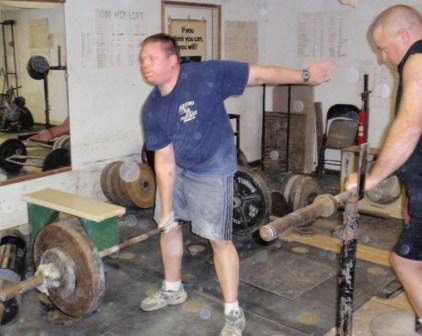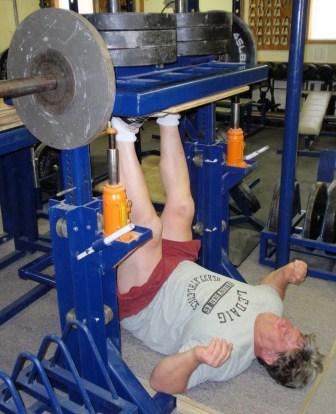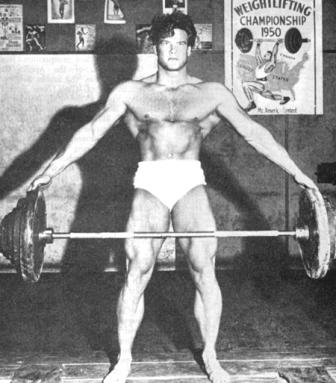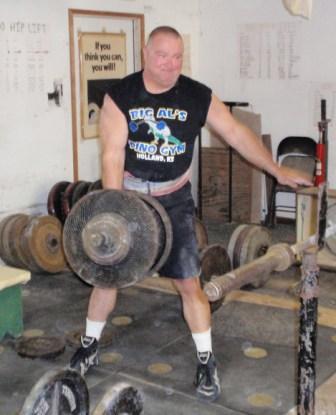by Thom Van Vleck
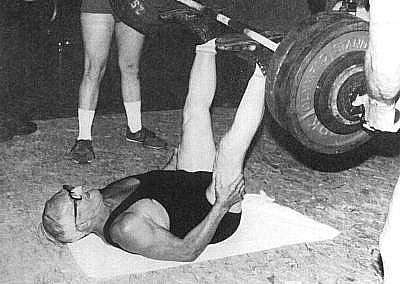
Ed Zercher performing an Unsupported Leg Press. In 1952, Ed Zercher did 200 reps with 250 pounds in 7 minutes, 30 seconds. In 1962, Ed Zercher did 10 reps with 605 pounds.
Recently I did a story on the “Zercher Lift” and “Zercher Squat” for Milo Magazine. I had been looking for a good picture of Ed Zercher doing a Zercher lift when I came across this photo (supplied to me by Al Myers). It is really quite a picture and you will find it in the rule book illustrating how to do the “Leg Press-Unsupported”. If you go into the average gym today and ask about the leg press, you will likely be pointed towards the “leg sled” or some variation of it which involves using the legs to press a sled loaded with weights at what is typically a 45 degree angle. Maybe, just maybe, you’ll find a leg press that is vertical where you lay under it and press the weight straight up in the air. But by USAWA standards, these lifts are not a true LEG PRESS!!!!
The rule book lists the rules as such:
D19. Leg Press – Unsupported
The lifter will lay on the platform, with the back, shoulders, and buttocks flat on the lifting surface. Padding, such as a towel or mat, may be placed under the lifter’s body, but must not exceed one-half inch in thickness. The bar will then be placed on the lifter’s feet by spotters, with the legs straight and the legs positioned at a 90 degree angle to the platform. Boots with heels are allowed to be worn. The spotters must not touch the lifter’s legs, the bar, or plates during the lift. Once the bar is motionless and under control, an official will give a command to start the lift. The lifter will bend the knees to lower the bar until the top of the thighs touch the torso, and will then recover and straighten the legs. The hands must not be braced or touching the legs during the lift. The lift ends on command. The bar may be removed from the lifter’s feet by spotters.
I recall doing these as part of my early training program in the late 70’s when I was a teen. I did these in a power rack, lying in the rack and taking the weight out like you would for a standing press out of the rack…..just with my feet! I did them with the pins in so I wouldn’t drop the weight on my self and close enough to the rack itself that if I lost my balance I’d drive the bar into the rack and press it up against the uprights for leverage (not really good on the bar and it’s always a must the power rack is secured to the floor if you are going to attempt this!). I didn’t do them because I was “old school”, I did them because I had no leg press to use in the first place. I learned them from my Uncle Wayne who learned them from Wilbur Miller.
I fell the unsupported Leg Press can have a lot of added benefits. First, you have the “feel” of a free weight. I’ve always felt the balance involved in a free weight lift makes one more athletic than any machine type lift. Second, you won’t likely use more weight than you can handle. Third, it will hit your legs more than your hips….at least it did mine. And finally, fourth, you will be familiar with the lift should you go to a USAWA meet that contests it some time.
There is also a variation on the Leg Press in the USAWA rule book called the Leg Press – Self Loaded. The rules of the Leg Press – Unsupported apply except the bar must be loaded onto the feet from the platform by the lifter only. The lifter may do so in any manner, but must not be assisted. I’ve never tried this one, but it sounds interesting and difficult….which could explain why I can’t find a single record on it! Like everything in the USAWA….it’s not the easy way!
